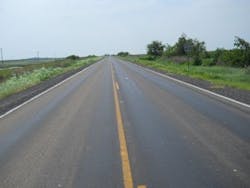Safety Down the Road
Daily rains, high tides and south winds of hurricane caliber had taken their toll on Louisiana Highway 3147, a coastal marsh state highway in Vermilion Parish, La. Located along the Gulf of Mexico, the road was disintegrating under the constant exposure to water, causing washouts and soft spots.
The Louisiana Department of Transportation and Development ordered a 12-in. limestone base and three-course surface treatment for the 5-mile stretch of road. The three-course surface treatment included the use of CRS-2P, a cationic rapid setting type of emulsified asphalt modified with the addition of polymers, and expanded clay lightweight aggregate (LWA) from Big River Industries.
| A close-up of the highway’s three-course surface treatment. |
“The three-course treatment used two applications of size 2 LWA, with a smaller, size 3 expanded clay LWA applied over top to help fill in gaps in the size 2 aggregate,” said Terry LeJeune, a Big River Industries representative. “This provides more skid resistance and makes the road safer, which is important under the wet conditions motorists regularly experience on this road.”
Applied by subcontractor P.R. Parker Co., this was the first three-course treatment the company conducted for the state, and one of the first that president Phillip Parker said he knows of being installed in Louisiana in at least 10 years.
“Louisiana has put more money into road preservation using chip seal,” Parker said. “This surface treatment seals the surface of existing pavement to keep water from infiltrating into the base and subgrade, which would cause the road to fail. Water acts as a lubricant on the soil and base below, allowing it to move and causing rutting and other base failures.”
It is Parker’s understanding that the state chose a three-course chip seal treatment for the road because it tends to have more water pass over it than a typical road. “Chip seal keeps water out better than any other surface in highway construction,” he said.
The Material
Expanded clay LWA has been used widely on all types of asphalt roads such as Highway 3147. Installation costs are competitive, and LWA offers advantages over ordinary aggregates.
According to Harold “Skip” Paul, director of the Louisiana Transportation Research Center (LTRC), expanded clay LWA performs as well as any other aggregate based on surveys evaluating LWA and other aggregate applications on roads over a 10-year span. “In fact,” he said, “it may even perform better in some cases.”
| The surface treatment included the use of CRS-2P. |
Expanded clay LWA is a ceramic material that is porous throughout, so as it wears, fresh interior cells with rough edges continually are exposed.
“Think of it as a sponge, which has holes throughout its thickness,” said Jeff Speck, vice president of sales and marketing for Big River Industries. “If you cut the sponge in half, you still expose the holes. Expanded clay LWA is surrounded by a ceramic matrix that is hard. Those holes and the surface together expose a rough texture. It never polishes because it is not a solid particle, whereas limestone is a solid particle.”
Under a number of friction tests conducted by researchers at the LTRC, Paul said there was no comparison to LWA. “Lightweight aggregates had the highest friction numbers. They scored 20 to 30 points above any other material out there,” he said. “It is the safest material from a friction perspective [especially where runoff is a concern].”
Economics & Expansion
The remote location of the Highway 3147 job proved to be the main challenge, with a pontoon bridge to maneuver across and special considerations to get equipment to the site, according to Parker.
“An advantage of using the lightweight material was the freight in trucking costs,” Parker said. “It performs as well as any other materials, and it is a whole lot less expensive to haul to the site. And in southern Louisiana, where there is no natural stone, it is a major concern.”
Expanded clay LWA is typically half the density of natural aggregate, resulting in 1 ton of LWA yielding twice the volume of natural material. “We can haul twice as much LWA in one load as hard crushed stone,” Parker said. “From an economic and environmental standpoint, this burns a lot less diesel fuel to get material there when you use lightweight. I recommend using LWA whenever geography makes cost a major issue and when skid resistance is a necessity.”
Ultimately, the application offers lower direct and indirect costs over the service life of the road. For this reason, more state and local transportation departments are specifying the use of LWA where storm water is an issue. With the lower costs—combined with the success of the research conducted by the LTRC—it seems likely that expanded clay LWA will become a commonality on other roads in the region, and in many parts of the country.


